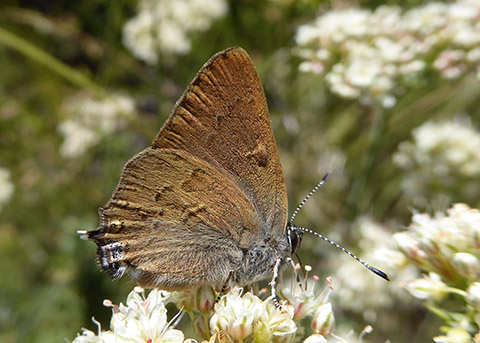
Quichito trail, Lake Elsinore, Riverside County, CA. 6/25/2019. © Robert Gorman
|
Gold-hunters Hairstreak
Satyrium auretorum spadix
Lepidoptera: Lycaenidae
Back to Butterflies of Orange County, California
Back to Arthropods of Orange County, California
Back to Natural History of Orange County, California |

El Cariso, Lake Elsinore, Riverside County, CA. 6/19/2019. © Robert Gorman |

El Cariso, Lake Elsinore, Riverside County, CA. 6/19/2019. © Robert Gorman |

El Cariso, Lake Elsinore, Riverside County, CA. 6/19/2019. © Robert Gorman |

El Cariso, Lake Elsinore, Riverside County, CA. 6/19/2019. © Robert Gorman |
Characteristics: Male--DW dark brown; female -- lighter
brown with a yellow-brown suffusion in the center of DFW (Emmel and Emmel, 1973) VW brown with few other
markings. Forewing length: 13-15 mm.
Similar Species: Satyrium tetra looks much like this species, but tetra usually possesses more of a gray hue on
the DW than spadix. The Spadix Hairstreak is dark or
light brown on the DW. The VW color of spadix is also of a lighter brown than that of tetra.
Habitats, Behavior: This scarce species is said to be highly
attracted to milkweed blossoms (Emmel and Emmel
1973). I have often seen it nectaring at buckwheat (Eriogonum spp.) in the Tehachapi Mountains and Mt. Pinos
region of Kern County.
Distribution: Recent records corne from John Cooper, Ron
Vanderhoff, and Jack Levy. Cooper mentions taking
specimens on several occasions in Silverado Canyon,
about one mile past the Silverado Historical Monument
on National Forest Road 5S16, always in June.
Flight Period: One brood, on the wing from mid-June to late July.
One record from Silverado Canyon is from
mid-May.
Larval Foodplant: Quercus dumosa (Scrub Oak) and possibly
Quercus wislizenii, both of which occur rather commonly
in the Santa Ana Mountains, are utilized by the larvae.
Other Remarks:Other Remarks: The peak flight period probably occurs dur
ing July when much of our local mountain area is closed
due to extreme fire danger. This may account for the
scarcity of records from Orange County. Also, colonies
of this butterfly are often rather localized, so if one
is not at the right place at the right time, the butterfly
probably will not be seen.
From Orsak, L. J. (1977). The Butterflies of Orange County, California. Center for Pathobiology Miscellaneous Publication #3. University of California Press, New York. 349pp.
Back to Butterflies of Orange County, California
Back to Arthropods of Orange County, California
Back to Natural History of Orange County, California
|




